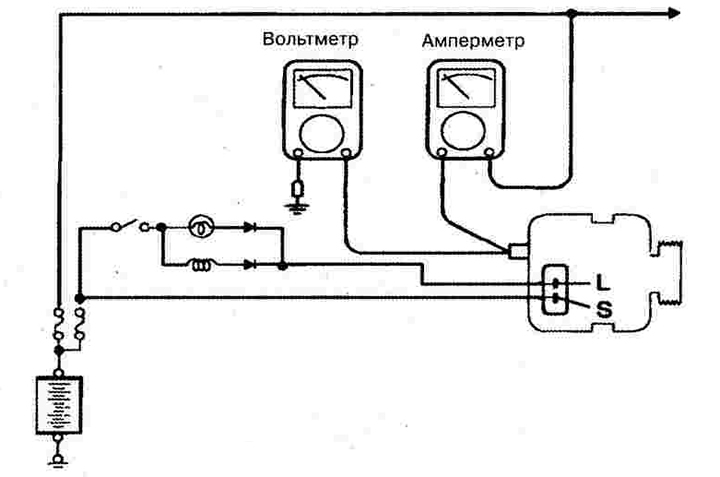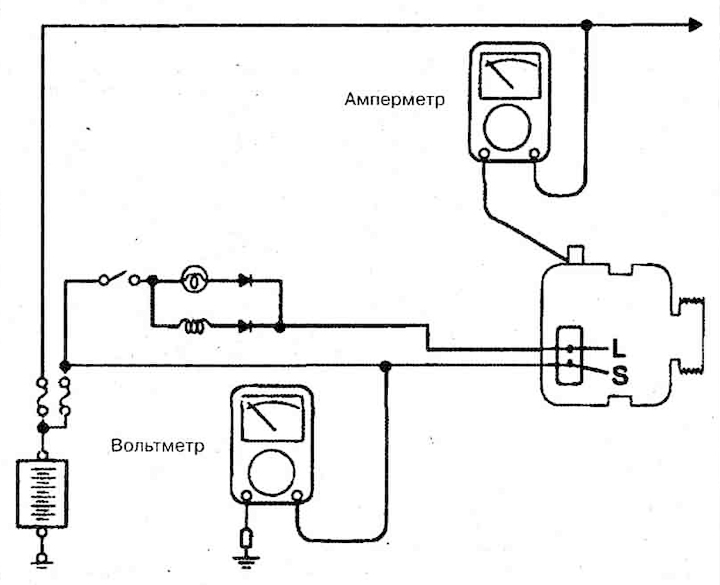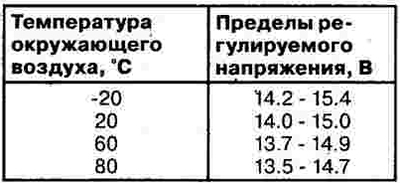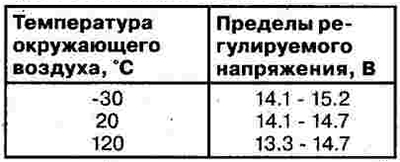Preparation for checking the output current of the generator
1. Before checking, carry out the following operations and, if necessary, troubleshoot:
a) Check the serviceability of the battery installed on the car and the level of its charge.
Note. When checking the output current of the generator, the battery must be partially discharged. With a fully charged battery, the test result will be inaccurate due to insufficient generator load.
b) Check alternator drive belt tension.
2. Set the ignition key to position «OFF» (turned off).
3. Disconnect the wire from the negative «-» battery outlet.
4. Disconnect the wire from the output «IN» generator.
5. Connect DC ammeter (with a measurement limit of 0-100 A), sequentially to the conclusion «IN» and the disconnected generator output wire. negative wire («-») ammeter connected to the disconnected output wire.
Note. Due to the high current, it is necessary to securely tighten both connections. Do not use type clamps «crocodile».
6. Connect a voltmeter (with a measurement limit of 0-20 V) to the conclusion «IN» And «mass» («-»): positive wire («+») voltmeter - to the conclusion «IN» generator, and the negative wire («-») - safe to «mass».
7. Connect a tachometer to control engine speed, connect the negative battery cable.
8. Leave the hood open.

Checking the output current of the generator
1. Make sure the voltmeter shows battery voltage. If the voltmeter shows 0 V, then possible causes are broken wires between the output «IN» generator and negative terminal («-») batteries, blown fuse or poor connection to «weight» («-»).
2. Start the engine and turn on the headlights.
3. Turn on the high beam headlights and the heater fan at the highest speed, sharply increase the crankshaft speed to 2500 rpm and read the maximum value of the generator output current using the ammeter.
Note. After starting the engine, the charging current decreases rapidly. Therefore, in order to obtain the true maximum current, the above operations should be carried out in as little time as possible.
Result
1. The ammeter reading must exceed the current limit. If it is lower with a good alternator output wire, remove the alternator from the vehicle and inspect it. current limit (generator 90 A) 63 Amin.
Note:
- 1. The rated value of the output current is indicated on the plate attached to the generator casing.
- 2. The value of the output current varies depending on the load current and the temperature of the generator. Therefore, the current value of the output current may differ from the nominal value. In this case, turn on the headlights to discharge the battery, or connect the headlights of another vehicle to increase the generator load current.
2. After checking the recoil current, reduce the engine speed to idle and turn off the ignition.
3. Disconnect the wire from the negative battery terminal.
4. Disconnect the ammeter, voltmeter and reference tachometer.
5. Connect the output wire to the output «IN» generator.
6. Connect the wire to the negative terminal of the battery.
The purpose of the adjustable voltage test is to check the functionality of the electronic voltage regulator.
Preparing to test the regulated voltage
1. Before checking, carry out the following operations and, if necessary, troubleshoot:
a) Check the condition of the battery installed in the vehicle.
b) Check alternator drive belt tension.
2. Set the ignition key to position «OFF» (turned off).
3. Disconnect the wire from the negative battery cable.
4. Connect a digital voltmeter to the output «S (L)» generator and to «mass» (positive wire («+») voltmeter - to the conclusion «S (L) «generator, and the negative wire of the voltmeter («-») - to the negative terminal («-») battery).
5. Disconnect the generator output wire from the output «IN».
6. Connect DC ammeter (with a measurement limit of 0-100 A) consecutively to the conclusion «IN» and to the disconnected generator output wire. minus pass («-») ammeter connected to the disconnected output wire.
7. Attach a tachometer to control engine speed and connect the negative wire to the battery.

Checking the regulated voltage
1. Turn on the ignition and make sure the voltmeter shows battery voltage.
If the voltmeter shows 0 V, then the cause is an open circuit between the output «S (L)» generator and positive terminal («+») battery or fuse burnt out.
2. Start the engine, turn off the headlights and all electrical consumers.
3. Increase the crankshaft speed to about 2500 rpm and read the voltmeter reading when the generator output current decreases to 10 A or less.
Result
1. If the voltmeter reading matches the values shown in the table below «Regulated voltage limits», the voltage regulator is operational.
If the voltmeter reading is out of range, the voltage regulator is faulty.
Gas engine

diesel engine

2. At the end of the test, reduce engine speed to idle and turn off the ignition.
3. Disconnect the negative battery cable.
4. Disconnect the voltmeter, ammeter and reference tachometer.
5. Connect the output wire to the output «IN» generator.
6. Connect the negative wire to the battery terminal.
